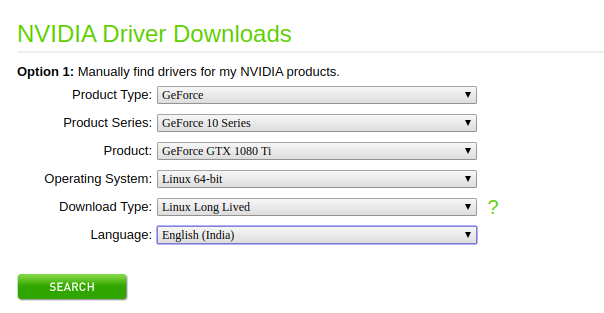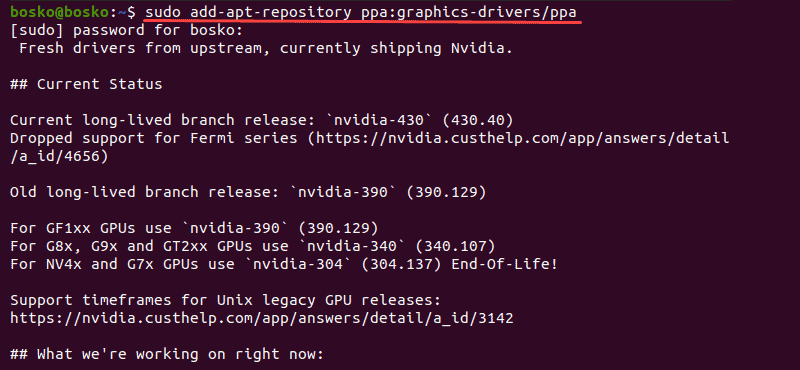

- #UBUNTU INSTALL LATEST NVIDIA DRIVERS DRIVERS#
- #UBUNTU INSTALL LATEST NVIDIA DRIVERS DRIVER#
- #UBUNTU INSTALL LATEST NVIDIA DRIVERS MANUAL#
This is not always straightforward, as the driver version depends on the kernel you have installed and the type of GPUs attached to the instance.

#UBUNTU INSTALL LATEST NVIDIA DRIVERS DRIVERS#
However, if you were to launch a GPU-enabled instance, you still have to figure out what version of NVIDIA GPU drivers to use, and install them.

We’re going to use it to showcase a new feature: NVIDIA driver installation.
Cloud-init.cloud-config: Cloud-init lets us set tons of parameters to influence first boot (and subsequent boots, too!). I found this image by going to, clicking on a suitable image (Minimal if you want a stripped-down, streamlined version in my case I just went with the non-minimal offering), and then finding the right OCID for the right availability domain You don’t have to pick any special GPU-enabled image. Note that this is just an off-the-shelf Ubuntu Image there are no special GPU drivers pre-linked into it. Image ID: The image ID I picked is Ubuntu 18.04. Subnet ID: You can find this in the Oracle Cloud Console by going to Networking -> Virtual Cloud Networks, selecting your network, selecting the subnet you wish to use, and then copying the OCID from there. Compartment ID: You can find your compartment by going to the (you may need a different region than us-ashburn-1), and finding the OCID of your compartment. It doesn’t matter too much where your availability domain is (provided you can launch GPU instances there), but you do need to know for the next steps. Availability-Domain: I’m in qIZq:US-ASHBURN-AD-1. VM.GPU2.1 has a NVIDIA Tesla P100 attached, which should do just fine for this purpose. Shape: I need an instance that has GPUS. I’ve elided some of my setup details from the command I’m using, feel free to plug in your own command arguments if you’d like to follow along. Using the CLI, let’s take a look at the command used to launch an instance oci compute instance launch -shape VM.GPU2.1 -availability-domain "qIZq:US-ASHBURN-AD-1" -compartment-id -assign-public-ip true -subnet-id -image-id ".aaaaaaaakdybjqysepqx2iwne24uxdx4apzdcn2ll7kd66a52fgs7w4mz3vq" -ssh-authorized-keys-file Let’s go dive in, shall we? ( Note: I will show examples using the Oracle CLI, but you can do this through the oracle web console as well.) Launching a new instance Now, you can automate this entire process on first boot. 
You had to figure out your kernel version, and drivers, and then search through package archives to find the right package.
#UBUNTU INSTALL LATEST NVIDIA DRIVERS MANUAL#
Previously, installing NVIDIA GPU drivers was a very manual process. I’m proud to be writing about a new feature that the Canonical team has been working on – NVIDIA GPU driver installation made easy for clouds. With advances in computer vision, AR/VR and other resource-intensive applications on the horizon, the trend shows no sign of slowing either. With cryptocurrency blossoming, AI/ML blooming, and heavy-duty simulations still going strong, the need for a GPU is only increasing. It’s no secret that GPGPUs (general purpose GPU) have been on the rise in the past five years. As a matter of fact, most public clouds have GPU offerings, which leads us to the meat of this blog post: Oracle Cloud. The cloud has had its own incredible growth over the years, and it’s only natural that these two technologies are starting to work in harmony. In recent reports, it is stated that datacenter-based GPU deployments is the fastest sector, and again, that’s no surprise.








 0 kommentar(er)
0 kommentar(er)
